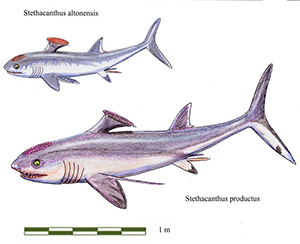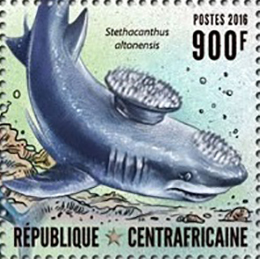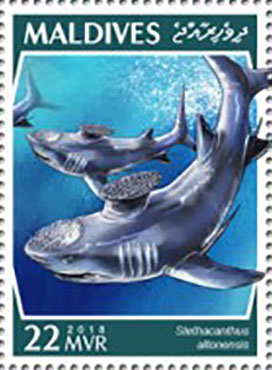Stethacanthus altonensis St. John and Worthen, 1875

(Da: it.wikipedia.org)
Phylum: Chordata Haeckel, 1874
Subphylum: Vertebrata Cuvier, 1812
Classe: Chondrichthyes Huxley, 1880
Ordine: Symmoriida Zangerl, 1981
Famiglia: Stethacanthidae Newberry, 1889
Genere: Stethacanthus John Strong Newberry, 1889
Specie e sottospecie
Il genere annovera attualmente le seguenti specie: Stethacanthus concavus Ginter, 2018 - Stethacanthus gansuensis<7i> Wang et al., 2004 - Stethacanthus neilsoni - Stethacanthus praecursor Hussakof & Bryant, 1918 - Stethacanthus productus Newberry, 1897 - Stethacanthus resistens - Stethacanthus thomasi.
Descrizione
Lungo meno di un metro, questo straordinario “squalo” era dotato di una bizzarra struttura dalla funzione sconosciuta: la pinna dorsale, nella parte superiore, era appiattita ed espansa, e andava a formare una superficie simile a quella di un'asse da stiro. Questa struttura, inoltre, era ricoperta da una moltitudine di piccoli aculei (versioni ingrandite dei denticoli dermici che normalmente ricoprono la pelle degli squali); anche la testa dello stetacanto era ricoperta da questi denticoli. Alcuni scienziati suppongono che queste strutture servissero all'animale durante il rituale dell'accoppiamento (sembra infatti che le femmine ne fossero sprovviste).
Diffusione
Pesce cartilagineo estinto, strettamente imparentato con gli squali. Visse tra la fine del Devoniano e l'inizio del Carbonifero (360-350 milioni di anni fa). I suoi resti sono stati rinvenuti in Scozia e in USA.
Sinonimi
= Symmorium reniforme? Cope, 1893.
Bibliografia
–Zangerl, Rainer (1984). "On the microscopic anatomy and possible function of the spine-"brush" complex of Stethacanthus (Elasmobranchii: Symmoriida)". Journal of Vertebrate Paleontology. 4 (3): 372-378.
–Lund, Richard; Greenfest-Allen, Emily; Grogan, Eileen D. (2015-02-01). "Ecomorphology of the Mississippian fishes of the Bear Gulch Limestone (Heath formation, Montana, USA)". Environmental Biology of Fishes. 98 (2): 739-754.
–Palmer, D., ed. (1999). The Marshall Illustrated Encyclopedia of Dinosaurs and Prehistoric Animals. London: Marshall Editions. p. 27.
–Maisey, J.G. (2007). "The braincase in Paleozoic symmoriiform and cladoselachian sharks". Bulletin of the American Museum of Natural History. 307: 1-122.
–Coates S.E.K., M.I.; Sequeira, S.E.K. (2001). "A new stethacanthid chondrichthyan from the lower Carboniferous of Bearsden, Scotland". Journal of Vertebrate Paleontology. 21 (3): 438-459.
–Coates, M. I.; Sequeira, S.E.K.; Sansom, I.J.; Smith, M.M. (December 1998). "Spines and tissues of ancient sharks". Nature. 396 (6713): 729-730.
–Maisey, John G. (2009). "The Spine-Brush Complex in Symmoriiform Sharks (Chondrichthyes: Symmoriiformes), with comments on dorsal fin modularity". Journal of Vertebrate Paleontology. 29 (1): 14-24.
–Lund, Richard (1985). "Stethacanthid elasmobranch remains from the Bear Gulch Limestone (Namurian E2b) of Montana". American Museum Novitates (2828): 1-24.
–Wood, S.P. (1982). "New basal Namurian (Upper Carboniferous) fishes and crustaceans found near Glasgow". Nature. 297 (5867): 574-7.
–Smith, M.M.; Coates, M.I. (2001). The evolution of vertebrate dentitions: phylogenetic pattern and developmental models. pp. 223-240.
–Walker, S.E.; Brett, C.E. (2002). "Predators and predation in Paleozoic marine environments". Paleontological Society Papers. 8: 93-118.
–Grogan, E.D.; Lund, R. (2002). "The geological and biological environment of the Bear Gulch Limestone (Mississippian of Montana, USA) and a model for its deposition". Geodiversitas. 24: 295-315.
–Lebedev, O.A. (1996). "Fish assemblages in the Tournaisian-Visean environments of the East European Platform". Geological Society, London, Special Publications. 107 (1): 387-415.
–N. Wang, J. Fan & W. Wang - 2004. Early Carboniferous Fishes (Acanthodian, Actinopterygians, and Chondrichthyes) from the East Sector of North Qilian Mountain, China - Vertebrata PalAsiatica 42 (2): 89-110.
–Trinajstic, Katherine (2014). "Devonian vertebrates from the Canning and Carnarvon Basins with an overview of Paleozoic vertebrates of Western Australia". Journal of the Royal Society of Western Australia. 97: 133-151.
–Burrow, Carole (2010). "Middle Palaeozoic microvertebrate assemblages and biogeography of East Gondwana (Australasia, Antarctica)". Palaeoworld. 19 (1-2): 37-54.
–Grogan, E.D.; Lund, Richard; Greenfest-Allen, E. (2012). "The Origin and Relationships of Early Chondrichthyans". Biology of Sharks and Their Relatives. CRC press, USA. pp. 3-29.
–Coates, M., Gess, R., Finarelli, J., Criswell, K., Tietjen, K. 2016. A symmoriiform chondrichthyan braincase and the origin of chimaeroid fishes. Nature.

|
Data: 21/11/2016
Emissione: Animali preistorici acquatici Stato: Central African Republic Nota: Emesso in un foglietto di 4 v. diversi |
|---|

|
Data: 08/10/2018
Emissione: Animali preistorici marini Stato: Maldives Nota: Emesso in un foglietto di 4 v. diversi |
|---|